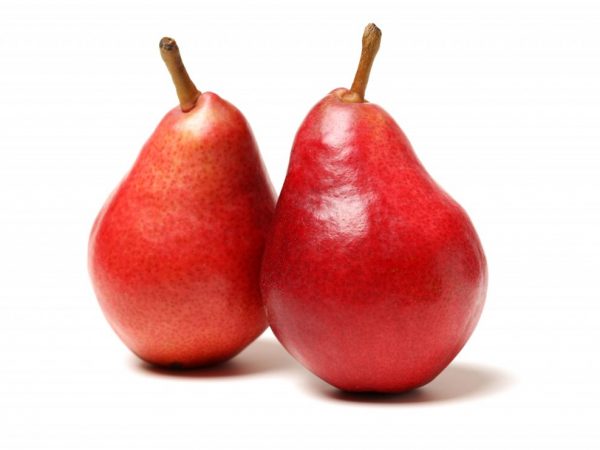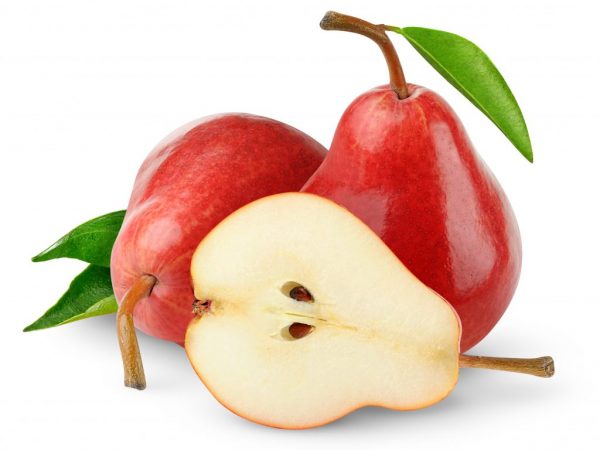Pear variety Red
Red pear is a popular variety with good taste. A detailed study of the variety allows you to grow it correctly, use beneficial properties and increase productivity.

Pear variety Red
Pear characteristics
The peculiarity of this variety is that it appeared not as a result of selection, but by natural mutation. For a long time, gardeners did not recognize this type of pear as an official variety of the fruit tree, but at the beginning of 1976, after a detailed analysis, the variety was officially recognized and named Williams red pear - Red Pear or Pear-Tomato.
Description of the tree
The foliage of the tree is asymmetrical, looks like a rounded or wide pyramid. Young trees are fast in growth, but by 10-12 years, growth slows down. In Williams, the decline is associated with good yields and early fruiting.
The bark is light yellow in color with a small number of lentils, covering thick, skeletal branches and trunk.
Pear Red has large egg-like leaves with a smooth surface. Small denticles are located on the elevated margins of the leaf blade; light green streaks are barely visible on the surface. Flowers of a white-cream shade are collected in inflorescences of 6-7 units, bloom until leaves appear and bloom for a long time.
Description of fruits
Fruits of 2-3 units are formed in inflorescences, hang on branches with a weight of 170 g, and on young trees - 180 g. Fruits of medium and large sizes are characterized by a slightly uneven surface, light green fragrant skin. After ripening, the Red pear turns yellow with gray dots, and a pink spot may appear on the fruits. The curved stalks help the pears to attach to the shoots. The pulp of the fruit is juicy, yellow-white, with sourness and nutmeg aroma.
Properties and composition of fruits
Red fruits have a rich composition of useful elements and properties:
- contain a large amount of fiber, potassium, vitamin C;
- do not contain sodium, cholesterol, saturated fat;
- low-calorie - 96 kcal;
- have a positive effect on blood circulation, heart and blood vessels;
- help cleanse the body;
- help fight obesity, diabetes.
Planting Red Pear
Preparing for landing
For planting, seedlings aged 1-2 years and a height of 1.3 to 1.5 m are suitable. The distance between the root collar and lateral shoots is more than 50 cm and 3-5 branches.
The length of the roots of seedlings reaches 20-30 cm. When planting, the quality of the formation of the central shoot, the complete absence of damage, shoots on the roots and dry leaves are important.
For planting the Williams variety, a place with a nutritious culvert soil, lack of groundwater at a shallow depth and illuminated by the sun is suitable.
Landing in the soil
At the end of the growing season, trees can be planted in autumn. Planting is allowed in a warm spring before the buds open.
The seedling is placed in a specially prepared groove 60 * 60 * 80 cm in size.The root system is covered with a special mixture of humus (one part), garden soil (one part), superphosphate (350 g), potassium sulfate (350 g).
Before planting, the roots are well examined, the dried parts are removed, they are kept in a heteroauxin solution for 3-12 hours. They are placed in a pit, covered with garden soil, a mixture, the seedling is watered abundantly, and the earth is filled up. A peg is placed in the area of the root system, to which the seedling is attached.
Red Pear Care

Finicky pear
Red pear, requires constant care.
Watering
After planting, the trees need constant watering for the first few years throughout the season. To preserve moisture, peat, buckwheat or pine nut husks are poured around the trunks with a layer thickness of 5-8 cm.
Mature trees become less demanding for watering, it takes about 3-7 times per season.
Fertilizer
Before the beginning of fruiting, the trees are fed annually in the spring. Manure is laid around with a layer of 4-6 cm, it is recommended to add 100-150 g of azofoska or Kemir under each tree.
In the autumn period of digging, feeding of adult trees is carried out. Mullein or a combination of organic, mineral fertilizers are used. They are distributed around the trunk and mixed at a depth of 25-35 cm to enrich the root system with nutrients.
Diseases and pests
Diseases
Red pear is susceptible to cytosporosis, fruit rot, scab, rust and root cancer.
Cytosporosis appears on the bark of the trunk and skeletal branches and is a brown-red spot. Cracks soon appear, the tissues of the bark soften.
You can fight the disease in the initial stages with the help of treatment with copper sulfate and garden varnish.
Rust spreads on the surface of the leaves from above and appears as round orange spots. Growths appear on diseased leaves from below, where rust spores are located.
Spraying with a 4% solution of Bordeaux liquid or a 2% solution of well sulfur before flowering and 2 weeks after it helps to overcome the disease.
Scab appears as green-black spots on the leaves, they increase, the leaves dry and crumble. The scab negatively affects the fruits and shoots, the pulp deteriorates under the spots. You can fight scab by eliminating spoiled fruits and foliage, spraying with colloidal sulfur and Bordeaux liquid.
Pests
The red pear suffers from aphids, pear leaf flies, pear gall mites, pear bugs, Californian scale insects, green apple aphids.
The larvae of the green apple aphid harm foliage, shoots, since they feed on their juices. To destroy them, use:
- Isophene;
- "Corsair";
- "Olekuprit".
Pear beetle larvae damage leaves, shoots, buds. Trees massively lose their foliage, ovaries and flowers deteriorate, the development of fruits is suspended. The fight against them is carried out by spraying with insecticides.
Conclusion
Growing a Red Pear is possible subject to all the features of planting, care and control of pests and diseases. Compliance with all the rules helps to get a rich harvest of fruits.


